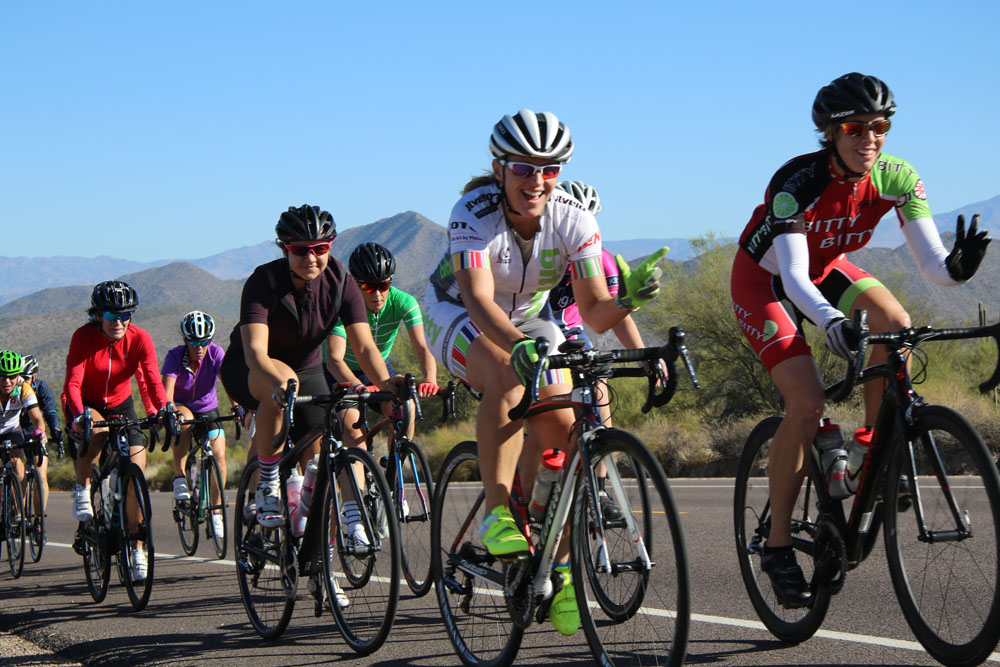
I started writing a post the other day about group riding techniques and it got pretty long and involved, so I decided to do a series of posts on the subject. With more people showing up to our Saturday morning MMC Road Ride, I felt the time was right to tackle a group riding introduction.
Riding in a group, like any language, becomes second nature with regular practice of proper techniques. The point of this first post is to give you a little background on group riding and to make the case for riding properly in a pack. Once you know how to “speak this language”, you’ll be able to keep yourself safe and enjoy the ride. Further, you’ll be able to identify a dangerous group ride and decide whether to bug out and ride on your own or not.
First, we have to ask, “Why ride in a group at all?” For racing, this skill is essential because race tactics involve taking advantage of drafting others. You can only do that if you’re riding closely behind another rider or riders and packs quickly form because of that. But for simply riding together, we do it because it’s a great way to make the sport social, to go somewhere with friends and to get exercise together.
So why not just ride together without all the rules and etiquette or, as I like to say, ride in a blob? First and foremost is safety. Group ride speeds can easily go from 15-50 mph while riding inches from each other. An example would be the Blue Angels, the Navy’s Flight Demonstration Team. They fly inches apart at 500 mph performing all sorts of aerobatic maneuvers and they do it with a safety record better than just about any road race. That’s no accident. They know what each person is going to do and when they are going to do it and they practice it over and over. Safety.
Without safety, it’s pretty hard to have fun, which is the other reason for not riding in a blob. Riding in an organized fashion is simply more fun. When you know how to ride the different pacelines well, and know what’s supposed to happen and when, you can enjoy yourself and those around you more. Remember, people have been riding together for over 100 years and the rules, techniques and etiquette were developed for a reason: they work. Instead of getting into the mechanics of pacelines, calling out obstacles, etc., let’s discuss a few overriding principles that I feel are important and that you’ll see come up time and time again: smoothness, communication and protecting your front wheel.
When we ride in a group, we want to ride with silky smoothness. What this means is that we don’t want to be swerving left and right erratically or surging ahead and slowing rapidly. Nobody rides in a perfectly straight line all the time, but we want to get close to that and we want our corrections to be slow, smooth and predictable. Second, we want our fore and aft movements to be gentle. If you’re going to speed up or slow down, we have to be cognizant that there’s someone right behind us who has to react to that. When they react to your changes, there’s a reaction time and they have to make a slightly more drastic adjustment than you did. That gets magnified with each rider behind you, to the point that someone is likely to run into someone else and fall. If you’re used to riding by yourself or one other person, it will be a surprise how erratic you may be and how smoothly it’s possible to ride. There are all sorts of tricks to enhance your smoothness in the bunch that I’ll talk about in future posts, but I’ll touch on two now. Steer from your hips and anticipate pace changes. Newer riders tend to be more erratic with their steering because they are understandably nervous riding so close to so many others. Their shoulders and arms stiffen up and they have a lot of hand pressure on the bars. Try relaxing your upper body and feeling your weight in your seat. This will allow you to steer more from your hips and your saddle and that alone will bring a dramatic improvement. As far as pace changes, many of them can be anticipated by looking ahead to several riders in front. When the pace in the bunch changes, reaction times create an accordion effect. By paying attention further up ahead, you’ll be ready for them and can make a smoother adjustment. The person sitting on your wheel will love you for it!
Any group of people that is working together towards a common goal needs to communicate effectively. Groups rides are no different. We do this by using hand signals and using our mouths; we talk to each other. For communication to be effective, it needs to be received, or at least given the opportunity to be received. Most obstacles and pace changes, etc. are initiated by the riders on the front of the bunch and they need to remember who their audience is: the riders behind. So, if we’re pointing to an obstacle but nobody can see our hand, it does no good; put your hand down and back where it can be seen. Further, if you’re calling something out verbally keep in mind that your mouth is facing away from your audience and there might be a fair amount of wind noise. Many times, all that can be heard is, “BLAHHHHHBAAP”. Or something similar to the teacher on Peanuts. Or was it the Principal? In any case, I make sure and keep the wind noise level in mind and I’ll usually turn my head slightly because I don’t like to shout. A group of constantly shouting cyclists may be a safe one but it’s annoying and usually is evidence of the opposite. More on riding silently and with grace another time.
Finally, let’s discuss protecting your front wheel. This is a big deal and I’ll just lead with this statement: if you let your front wheel touch a wheel in front of you, you’re probably hitting the deck. HARD. And if you hit the deck, others have to avoid the tumbling you and some probably won’t be successful. It turns a nice little Saturday ugly, fast. The front wheel is the steerable wheel (duh) and it has less weight on it. Further, the front of your front tire is traveling downward. The rear of the tire in front of you is traveling upward. They are both grippy rubber surfaces and often when they meet, your front tire rides up the tire in front of you and turns your handlebars just enough that when your front tire lands, and this happens in a split second, it’s not pointed straight. Talk about tough to control. So how do we avoid this? Start by giving that wheel ahead a little room, especially if you’re new to group rides or the person in front is not very smooth. Give it a whole wheel’s width (2-3 feet) and you won’t miss much draft but you’ll be able to “soak up” much of the surging in front of you. Second, never (I’ll make myself a liar in Part 3) EVER allow your front wheel to come up alongside the wheel in front of you. If you do that, the rider in front could easily move over into your wheel and take it out from under you. SWEEP THE LEG, JOHNNY! Karate Kid, get it? Really?… So that’s a bad deal, too. Finally, smoothness comes into play, as always. Remember, if you’re not paying attention and you slam on your brakes to avoid the wheel ahead, you don’t give the person on YOUR wheel much of a chance. We’re all connected in the bunch! So, anticipate and be smooth. I’ve got some other, more advanced techniques I’ll hit on later but you’d be amazed at how good you can get at doing all of this while chatting, drinking and eating. The really good ones are amazing to watch and are cyclists to emulate.
In the meantime, if you can’t do this while being super chatty and eating and drinking, don’t. Focus on riding in the bunch. There’s not much worse than someone who’s chatting up a storm and swerving and acting cool because they’ve seen really good riders do that. Too soon. Gotta learn to walk before you run.
Finally, I should mention that these posts are meant to be a good overview of riding in a group that is trying to stay together. Euro style. Not the unsanctioned races that pass for group rides all over the Valley these days. Those can be fun (and sometimes more dangerous than necessary) and employ more of a race tactic vibe, the element of surprise and putting others in the hurt locker. Next up, we’ll get into the different types of pacelines that are used in group rides and how to ride in them. Take care and I hope to see you on a ride soon!
Brent
